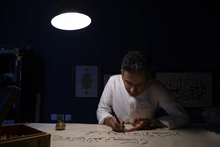Arabic calligraphy
| Part of a series on |
| Calligraphy |
|---|
 |


Arabic calligraphy is the artistic practice of
From an artistic point of view, Arabic calligraphy has been known and appreciated for its diversity and great potential for development. In fact, it has been linked in the
Although most
Arabic alphabet
The Arabic alphabet is one of the most widely used scripts in the world. Many scholars believe that the alphabet was created around the 4th century CE.[4] The alphabet consists of 28 letters written from right to left. Each letter can be written in four ways, depending on where the letter is placed in a word. These four locations are also known as initial, medial, final and isolated.
Implements
The pens used for Arabic calligraphy vary from Latin calligraphy. The tools used for calligraphy are different assortments of pens and calligraphy ink. The most common calligraphy pen used is Qalam.[5]
Khamish pen
The Khamish pen also known as a reed pen is used by Arab, Turkish, and Iranian calligraphers. The reed of the pen is grown along rivers. Although this pen has been used for over 500 years, preparing the pen is a lengthy process.[6]
Java pen
The Java pen is known for the tool's hardness and ability to create sharp edges. The pen is good to use for small scripts.
Handam pen
The Handam pen consists of the same strength that the Java pen has. The pen is good to use for all kinds of scripts.[7]
Celi pen
The Celi pen is used for large writing in Arabic calligraphy. These pens are made from hardwood and cut and drilled.[8]
Scripts
Popular scripts
The two most popular scripts used for Arabic calligraphy are Kufic and Naskh. Kūfic was derived from Iraq and initially used for inscription on stone and metal. Naskhī originated from Mecca and Medina. The script is used as a cursive script, for example on papyrus and paper.
Other scripts
The
The Thuluth script used during the medieval times is known as one of the oldest scripts to exist. The script was used on mosques and for Quranic text due to the appearance of the text.
The Nasta'liq script is used more for Persian than Arabic scripting. Because of the upward slant to the left,[9] the script is seen as different from the other scripts. The cursive look creates an elegant look when creating.
The Diwani Script was created during the Ottoman era. The lining and lettering of this script creates a sense of closeness when writing. Due to this reason, it's difficult to read since the letters intertwine.[9]
List of calligraphers
Some classical calligraphers:
Medieval
- Ibn Muqla (d. 939/940)
- Ibn al-Bawwab (d. 1022)
- Fakhr-un-Nisa (12th century)
Ottoman era
- Shaykh Hamdullah (1436–1520)
- Hamid Aytaç (1891-1982)
- Seyyid Kasim Gubari (d. 1624)
- Hâfiz Osman (1642–1698)
- Mustafa Râkim (1757–1826)
- Mehmed Shevki Efendi(1829–1887)
Contemporary
- Hasan Çelebi (b. 1937), Turkey
- Ali Adjalli (b. 1939), Iran
- Wijdan Ali (b. 1939), Jordan
- Hashem Muhammad al-Baghdadi, Iraq
- Everitte Barbee (b. 1988), United States of America
- Mohammad Hosni Syria
- Shakkir Hassan Al Sa'id (1925-2004) in Iraq
- Madiha Omar Iraqi-American
- Hassan Massoudy Iraqi-French (b. 1944)
- Sadequain Naqqash (1930-1987), Pakistan
- Ibrahim el-Salahi(b. 1930), Sudan
- Mouneer Al-Shaarani (b. 1952), Syria
- Mahmoud Taha (b. 1942), Jordan
- Mohamed Zakariya (b. 1942), United States of America
- Uthman Taha (b. 1934), Syria
- Shafiq-Uz-Zaman Khan Pakistan
Legacy
Type design and type setting
Arabic calligraphy serves as a major source of inspiration for
The shift from Arabic calligraphy to Arabic typefaces presents technical challenges, as Arabic is essentially a cursive script with contextual shapes.[citation needed]
Art
EL Seed, a French-Tunisian graffiti artist, makes use of Arabic calligraphy in his various art projects, in a style called calligraffiti.[11]
The Hurufiyya (الحروفية letters) movement, since its beginnings in the early 20th century, uses the artistic manipulation of Arabic calligraphy and typography in abstraction.[12]
Taking Shape: Abstraction From the Arab World, 1950s-1980s, a 2020 installation at New York University's
Modern examples
-
The Emirates logo is written in traditional Arabic calligraphy
-
Logo of Prince Mohammed Bin Salman Global Center for Arabic Calligraphy
-
The official logo of the Saudi Tourism website that translates to "Visit Saudi".
-
Logo of the Saudi National Center for Archives and Records
-
Logo of Al Jazeera Media Network
See also
References
- ^ Julia Kaestle (10 July 2010). "Arabic calligraphy as a typographic exercise".
- ISBN 978-3-640-93875-9.
- OCLC 191880956.
- ^ "Arabic alphabet | Chart, Letters, & Calligraphy". 22 June 2023.
- ^ "Lettering Pens – Huge overview". 2018-05-15. Retrieved 2019-04-25.
- ^ "The Kamish Pen". Arabic Calligraphy Supplies.
- ^ "The Handam Pen". Arabic Calligraphy Supplies.
- ^ "The Celi Pen". Arabic Calligraphy Supplies.
- ^ a b "Arabic Writing and Scripts: A Brief Guide | Shutterstock". 24 July 2014.
- ^ Hosny, Khaled (2012). "The Amiri typeface" (PDF). TUGboat. 33: 12. Archived (PDF) from the original on 2022-10-09.
- ^ PopTech (2011), eL Seed: The Art of Calligraffiti, retrieved 2020-02-24
- ^ "NYU Grey Art Gallery Spotlights Pioneers of Arab Art". 2020-02-07. Retrieved 2020-02-25.
- ^ ISSN 0362-4331. Retrieved 2020-02-24.
External links
 Media related to Arabic calligraphy at Wikimedia Commons
Media related to Arabic calligraphy at Wikimedia Commons








